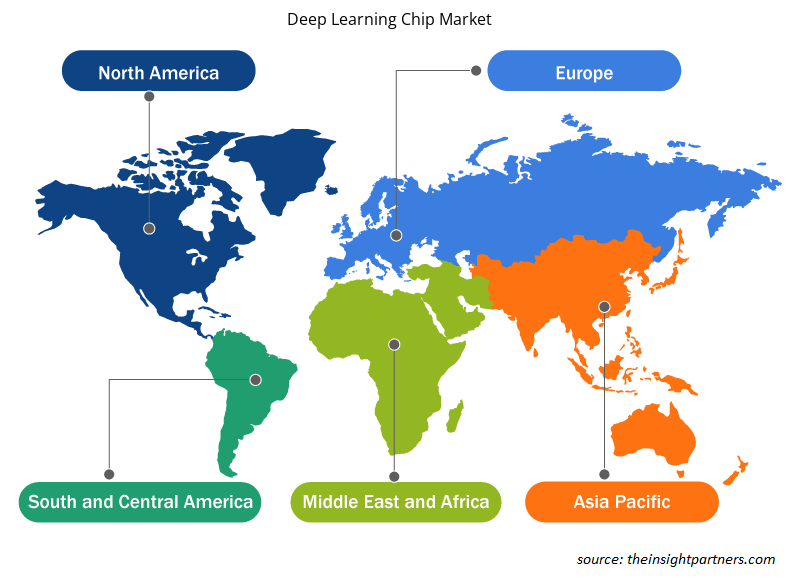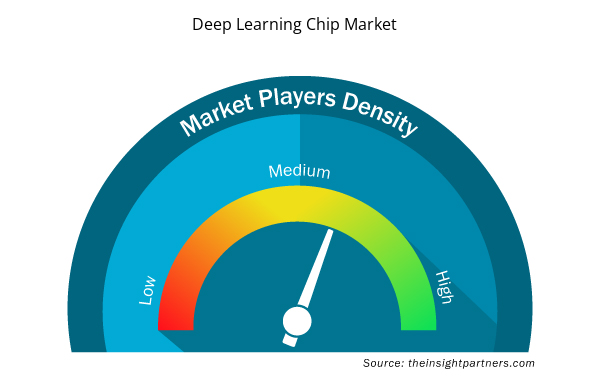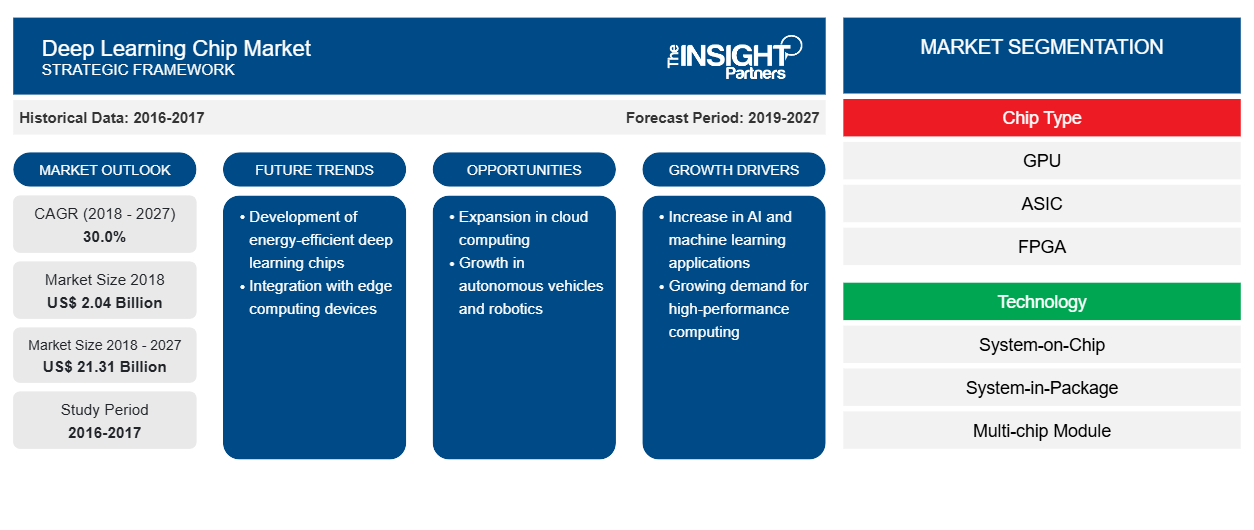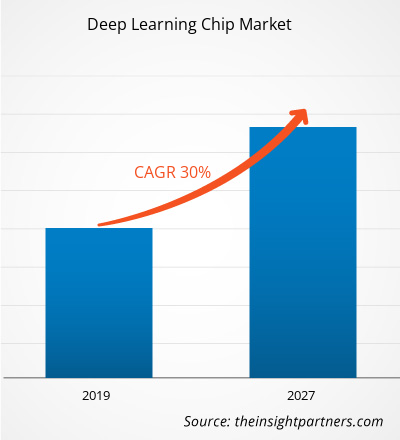2018 年全球深度学习芯片市场规模为 20.4 亿美元,预计2019 年至 2027 年预测期内的复合年增长率为 30.0%,到 2027 年将达到 213.1亿美元。
北美引领全球深度学习芯片市场,预计在整个预测期内将成为最大的收入贡献者。深度学习芯片的开发得到了科技巨头的大规模投资支持,旨在从大量生成的数据中开发模式。量子计算的兴起和深度学习芯片在机器人技术中的应用正在推动北美国家深度学习芯片市场的增长。
市场洞察
量子计算的突出表现推动了深度学习芯片市场的增长
量子计算需要几秒钟才能完成原本需要更多时间的计算。量子计算机是人工智能、机器学习和大数据的创新转型。因此,量子计算的突出地位有望推动深度学习芯片市场的增长。此外,量子计算有利于各种因素,包括投资组合优化、欺诈检测和风险管理,以及需要即时数据反馈的领域。因此,单个处理器更容易在几秒钟内执行复杂的计算。此外,凭借互联网的规模和规模,深度学习有助于以极低的成本维护大型数据集。因此,这些因素有望推动全球深度学习芯片市场的增长
定制此报告以满足您的需求
您可以免费定制任何报告,包括本报告的部分内容、国家级分析、Excel 数据包,以及为初创企业和大学提供优惠和折扣
- 获取此报告的关键市场趋势。这个免费样品将包括数据分析,从市场趋势到估计和预测。
实时消费者行为洞察和运营效率提升推动深度学习芯片市场整体增长
商业性质正变得非常具有竞争力,为了有效竞争,如今的企业依赖于有用的信息和业务分析。传统上,业务分析工具用于根据一周或一个月前事件的数据来预测销售额。随着实时学习并根据模式提供建议的人工智能技术的出现,企业有巨大的机会在各种流程中应用深度学习,以更好地了解商业环境和客户。
考虑到这些因素,人工智能使企业能够提高运营效率,降低运营成本,提升服务质量和客户体验。
芯片类型洞察
图形处理单元 (GPU) 在 2018 年占据了深度学习芯片市场的主要份额,而专用集成电路 (ASIC) 预计将成为预测期内增长最快的细分市场。由于 ASIC 非常专用且灵活性较差,但它们是人工智能应用可用的性能最高的硬件选项之一。
技术洞察
深度学习芯片组包括片上系统、系统级封装、多芯片模块等,以及其他芯片组。片上系统部分在 2018 年占据了深度学习芯片市场的主要份额,因为它有助于减少能源浪费、大型系统占用的空间和成本。
行业垂直洞察
全球深度学习芯片市场分为 BFSI、零售、IT 和电信、汽车和运输、医疗保健、媒体和娱乐等。BFSI 在深度学习芯片市场中占据主要市场份额,而医疗保健预计将成为市场中增长最快的部分。降低运营成本、适应不断变化的合规性和法规、专注于核心业务以及将自动化集成到业务流程中等因素是推动深度学习芯片市场 BFSI 部分增长的其他主要因素
深度学习芯片市场的市场参与者主要专注于通过实施先进技术来增强产品性能。通过签署合作伙伴关系、合同、合资企业、融资和在世界各地开设新办事处,该公司得以在全球范围内保持其品牌名称。以下列出了一些最新进展;
2019 年:NVIDIA 与 Hackster.io 合作推出 AI at the Edge Challenge,这是一项竞赛,开发人员利用 NVIDIA Jetson Nano 开发套件构建富有创意的独特项目,并有机会赢得 10 万美元的奖金。
2019 年:英特尔宣布计划扩建俄勒冈工厂,以生产 7nm 芯片。英特尔的新工厂将是 D1X 的第三阶段,这是英特尔于 2010 年开始建设的大型工厂。前两个阶段各占地 110 万平方英尺,合并后的设施相当于 15 家 Costco 仓储店。第三阶段显然将使 D1X 的制造空间增加约 50%。此外,英特尔表示,工厂扩建将使其能够以更快 60% 的速度应对芯片短缺。
2019年,华为推出业界首款T级AIFW HiSecEngine USG12000。HiSecEngine USG12000搭载Ascend AI芯片,为企业网络提供智能检测能力和智能边界防御。
深度学习芯片市场区域洞察
Insight Partners 的分析师已详细解释了预测期内影响深度学习芯片市场的区域趋势和因素。本节还讨论了北美、欧洲、亚太地区、中东和非洲以及南美和中美洲的深度学习芯片市场细分和地理位置。

- 获取深度学习芯片市场的区域特定数据
深度学习芯片市场报告范围
| 报告属性 | 细节 |
|---|---|
| 2018 年市场规模 | 20.4 亿美元 |
| 2027 年市场规模 | 213.1亿美元 |
| 全球复合年增长率(2018 - 2027) | 30.0% |
| 史料 | 2016-2017 |
| 预测期 | 2019-2027 |
| 涵盖的领域 | 按芯片类型
|
| 覆盖地区和国家 | 北美
|
| 市场领导者和主要公司简介 |
|
市场参与者密度:了解其对商业动态的影响
深度学习芯片市场正在快速增长,这得益于终端用户需求的不断增长,而这些需求又源于消费者偏好的不断变化、技术进步以及对产品优势的认识不断提高等因素。随着需求的增加,企业正在扩大其产品范围,进行创新以满足消费者的需求,并利用新兴趋势,从而进一步推动市场增长。
市场参与者密度是指在特定市场或行业内运营的企业或公司的分布情况。它表明在给定市场空间中,相对于其规模或总市场价值,有多少竞争对手(市场参与者)存在。
在深度学习芯片市场运营的主要公司有:
- 美国超微半导体公司
- Alphabet Inc.(谷歌)
- 亚马逊公司 (Amazon.com, Inc.)
- 百度公司
- 华为技术有限公司
免责声明:上面列出的公司没有按照任何特定顺序排列。

- 了解深度学习芯片市场顶级关键参与者概况
全球深度学习芯片市场细分
按芯片类型
- 图形处理器
- 专用集成电路 (ASIC)
- FPGA
- 中央处理器
- 其他的
按技术分类
- 片上系统
- 系统级封装
- 多芯片模块
- 其他的
按垂直行业
- 媒体与广告
- BFSI、IT 和电信
- 零售
- 卫生保健
- 汽车与运输
- 其他的
按地理位置
北美
- 我们
- 加拿大
- 墨西哥
欧洲
- 法国
- 德国
- 英国
- 俄罗斯
- 意大利
- 欧洲其他地区
亚太地区 (APAC)
- 澳大利亚
- 中国
- 印度
- 日本
- 韩国
- 亚太地区其他地区
中东和非洲 (MEA)
- 沙特阿拉伯
- 南非
- 阿联酋
- MEA 其他地区
南美洲 (SAM)
- 巴西
- 阿根廷
- SAM 其余部分
公司简介
- 美国超微半导体公司
- Alphabet Inc.(谷歌)
- 亚马逊公司 (Amazon.com, Inc.)
- 百度公司
- 华为技术有限公司
- 英特尔公司
- NVIDIA 公司
- 高通公司
- 三星电子有限公司
- Xilinx 公司
- 历史分析(2 年)、基准年、预测(7 年)及复合年增长率
- PEST 和 SWOT 分析
- 市场规模价值/数量 - 全球、区域、国家
- 行业和竞争格局
- Excel 数据集


- 3D Audio Market
- Blood Collection Devices Market
- Electronic Shelf Label Market
- Rugged Servers Market
- Explosion-Proof Equipment Market
- Predictive Maintenance Market
- Industrial Valves Market
- Public Key Infrastructure Market
- Advanced Planning and Scheduling Software Market
- Europe Industrial Chillers Market

Report Coverage
Revenue forecast, Company Analysis, Industry landscape, Growth factors, and Trends

Segment Covered
This text is related
to segments covered.

Regional Scope
North America, Europe, Asia Pacific, Middle East & Africa, South & Central America

Country Scope
This text is related
to country scope.
常见问题
The BFSI industry dominated the deep learning chip market in the year 2018. Banking, financial services, and insurance (BFSI) industries have great potential for deep learning chips due to the presence of huge financial and personal data of customers. In this sector, a high amount of sensitive data is generated and exchanged every day. There is growing volume and creation of endpoints and mobile devices in banks, credit card companies, and credit reporting institutions, thus, it becomes important for these industry verticals to harness this data to gain insights about various business aspects.
Presently, the major applications of deep learning chips are in the data center/cloud computing segment, and this trend is expected to continue during the forecast period. Also, majorly due to rising adoption of AI in developing regions, evolving architectures of deep learning chips and increasing applications across various industry verticals. Owing to this growing trend, the companies are anticipated to produce high-quality service by adopting cloud-based artificial intelligence services.
North America is one of the fastest-growing regions in terms of technological development. In the past 3 years, the region witnessed significant adoption of AI solutions across all the sectors. North America contributes the largest market share in terms of revenue, and it is estimated that it will continue its dominance in the market share during the forecast period. Deep learning chip development is backed by large-scale investment from technological giants to develop patterns from huge amount of generated data. The rise of quantum computing and implementation of deep learning chips in robotics drive the growth of the deep learning chip market in the North American countries.
Trends and growth analysis reports related to Electronics and Semiconductor : READ MORE..
The List of Companies - Deep Learning Chip Market
- Advanced Micro Devices, Inc.
- Alphabet Inc. (Google)
- Amazon.com, Inc.
- Baidu, Inc.
- Huawei Technologies Co., Ltd
- Intel Corporation
- NVIDIA Corporation
- Qualcomm Incorporated
- Samsung Electronics Co., Ltd.
- Xilinx, Inc.
The Insight Partners performs research in 4 major stages: Data Collection & Secondary Research, Primary Research, Data Analysis and Data Triangulation & Final Review.
- Data Collection and Secondary Research:
As a market research and consulting firm operating from a decade, we have published and advised several client across the globe. First step for any study will start with an assessment of currently available data and insights from existing reports. Further, historical and current market information is collected from Investor Presentations, Annual Reports, SEC Filings, etc., and other information related to company’s performance and market positioning are gathered from Paid Databases (Factiva, Hoovers, and Reuters) and various other publications available in public domain.
Several associations trade associates, technical forums, institutes, societies and organization are accessed to gain technical as well as market related insights through their publications such as research papers, blogs and press releases related to the studies are referred to get cues about the market. Further, white papers, journals, magazines, and other news articles published in last 3 years are scrutinized and analyzed to understand the current market trends.
- Primary Research:
The primarily interview analysis comprise of data obtained from industry participants interview and answers to survey questions gathered by in-house primary team.
For primary research, interviews are conducted with industry experts/CEOs/Marketing Managers/VPs/Subject Matter Experts from both demand and supply side to get a 360-degree view of the market. The primary team conducts several interviews based on the complexity of the markets to understand the various market trends and dynamics which makes research more credible and precise.
A typical research interview fulfils the following functions:
- Provides first-hand information on the market size, market trends, growth trends, competitive landscape, and outlook
- Validates and strengthens in-house secondary research findings
- Develops the analysis team’s expertise and market understanding
Primary research involves email interactions and telephone interviews for each market, category, segment, and sub-segment across geographies. The participants who typically take part in such a process include, but are not limited to:
- Industry participants: VPs, business development managers, market intelligence managers and national sales managers
- Outside experts: Valuation experts, research analysts and key opinion leaders specializing in the electronics and semiconductor industry.
Below is the breakup of our primary respondents by company, designation, and region:

Once we receive the confirmation from primary research sources or primary respondents, we finalize the base year market estimation and forecast the data as per the macroeconomic and microeconomic factors assessed during data collection.
- Data Analysis:
Once data is validated through both secondary as well as primary respondents, we finalize the market estimations by hypothesis formulation and factor analysis at regional and country level.
- Macro-Economic Factor Analysis:
We analyse macroeconomic indicators such the gross domestic product (GDP), increase in the demand for goods and services across industries, technological advancement, regional economic growth, governmental policies, the influence of COVID-19, PEST analysis, and other aspects. This analysis aids in setting benchmarks for various nations/regions and approximating market splits. Additionally, the general trend of the aforementioned components aid in determining the market's development possibilities.
- Country Level Data:
Various factors that are especially aligned to the country are taken into account to determine the market size for a certain area and country, including the presence of vendors, such as headquarters and offices, the country's GDP, demand patterns, and industry growth. To comprehend the market dynamics for the nation, a number of growth variables, inhibitors, application areas, and current market trends are researched. The aforementioned elements aid in determining the country's overall market's growth potential.
- Company Profile:
The “Table of Contents” is formulated by listing and analyzing more than 25 - 30 companies operating in the market ecosystem across geographies. However, we profile only 10 companies as a standard practice in our syndicate reports. These 10 companies comprise leading, emerging, and regional players. Nonetheless, our analysis is not restricted to the 10 listed companies, we also analyze other companies present in the market to develop a holistic view and understand the prevailing trends. The “Company Profiles” section in the report covers key facts, business description, products & services, financial information, SWOT analysis, and key developments. The financial information presented is extracted from the annual reports and official documents of the publicly listed companies. Upon collecting the information for the sections of respective companies, we verify them via various primary sources and then compile the data in respective company profiles. The company level information helps us in deriving the base number as well as in forecasting the market size.
- Developing Base Number:
Aggregation of sales statistics (2020-2022) and macro-economic factor, and other secondary and primary research insights are utilized to arrive at base number and related market shares for 2022. The data gaps are identified in this step and relevant market data is analyzed, collected from paid primary interviews or databases. On finalizing the base year market size, forecasts are developed on the basis of macro-economic, industry and market growth factors and company level analysis.
- Data Triangulation and Final Review:
The market findings and base year market size calculations are validated from supply as well as demand side. Demand side validations are based on macro-economic factor analysis and benchmarks for respective regions and countries. In case of supply side validations, revenues of major companies are estimated (in case not available) based on industry benchmark, approximate number of employees, product portfolio, and primary interviews revenues are gathered. Further revenue from target product/service segment is assessed to avoid overshooting of market statistics. In case of heavy deviations between supply and demand side values, all thes steps are repeated to achieve synchronization.
We follow an iterative model, wherein we share our research findings with Subject Matter Experts (SME’s) and Key Opinion Leaders (KOLs) until consensus view of the market is not formulated – this model negates any drastic deviation in the opinions of experts. Only validated and universally acceptable research findings are quoted in our reports.
We have important check points that we use to validate our research findings – which we call – data triangulation, where we validate the information, we generate from secondary sources with primary interviews and then we re-validate with our internal data bases and Subject matter experts. This comprehensive model enables us to deliver high quality, reliable data in shortest possible time.


 获取此报告的免费样本
获取此报告的免费样本